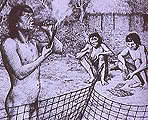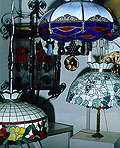When great Genoese Admiral Christopher
Columbus arrived at "the most beautiful land human eyes
have ever seen", the population of Cuba was made up of indigenous
communities skilled in agriculture and the art of pottery.
The agriculturists developed utensils using shells creating
knives, vessels, gouges, necklaces, and even garments for
daily and ceremonial use. The potters developed ceramic
art, which, according to the amount of fragments and pieces
that have been found, can be considered as significant in
the economic and cultural life of those groups. They also
laboured in wood and basketwork. Wood was used to build
huts and log cabins and to make the canoes they used for
navigation. Their skills in woodcarving are evident in the
dujos (a type of carved chair), the cemies ( carved Gods)
and the drums, called atabales or mayohuacan. In traditional
handicrafts of mostly Central and South American countries
the signs of the first inhabitants are still preserved,
in the case of Cuba it is difficult to establish the possible
links between pieces that shape artisan traditions in vogue
and native manufacture. This historic legacy is known through
chronicles from the conquest period and through the work
of anthropologists and archaeologists.
The African culture furnished popular handicrafts
with countless rudiments. The most representative are seed-works
and pottery. These artisans had to adopt fresh materials
and textures in the new tropical environment in order to
preserve their original practical or ceremonial elements,
so as to guarantee the continuity and permanence of their
traditions.
Nowadays, most craftsmen are students,
graduates from art schools or people who have some knowledge
of designing or drawing. Some create for the purpose of
artistic expression, others just to sell as souvenirs for
tourists. Contemporary craftsmanship produces several articles
for everyday use, now supported by industries that supply
the necessary raw materials. Though, in some cases the object
is aesthetic and decorative, real artists are few. Julio
Cesar Garrido and Carlos Espinosa are notable for their
accomplishments with leather and cedar for cigar boxes and
others related to that product. Their works are sold at
auction during the Havana Cigars Congress.
We offer a special mention for artist and ceramist Alfredo
Sosabravo, awarded the National Prize for Fine Arts on 1998
for his life's work, in which ceramics excels.
Cuban artisans make up the greater part of all souvenir
sales in most cities around the island. Very few souvenirs
are mass-produced and each has it's own personal tale.












































